| Q |
HISTOGRAM |
ANALYSIS |
| 0 |
DISTRIBUTION OF SELECTED ANSWERS
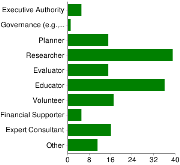 |
CURRENT ROLE IN SUSTAINABLE DEVELOPMENT
The header of this question is as follows:
- What is your current role in sustainable development?
Select all that apply:
Roles & Percentages Roles Ranked by Percentage
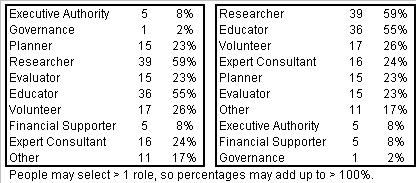
Mostly researchers and educators, few participants in roles of authority.
|
| 1 |
DISTRIBUTION OF SELECTED ANSWERS
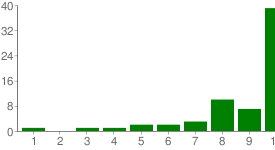
Relevance scale: 1 to 10
1 = Irrelevant, 10 = Critical
It should be noted that gender equity (fairness) is a better term than gender equality (sameness). But UNESCO uses "gender equality," and gender equality is generally used to mean gender equity, so let's use the UNESCO terminology. |
SECTION ON EDUCATION FOR GENDER EQUALITY/EQUITY
The header of this question is as follows:
- What is the importance of gender equality for sustainable development?
Select the level of importance in a 1-10 scale (1 is irrelevant, 10 is critical).
Pareto Ranking
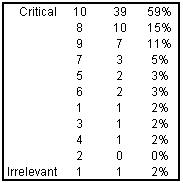 59% of the participants think that gender equality is the top driver of sustainable development, 85% think that it is a key factor.
|
| 2 |
DISTRIBUTION OF SELECTED ANSWERS
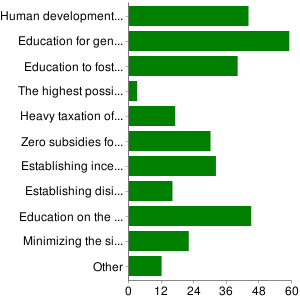 |
SECTION ON EDUCATION FOR GENDER EQUALITY/EQUITY
The header of this question is as follows:
- Which of the following factors/issues are significant to make progress toward gender equality?
Select all that apply:
Ranking by Percentage
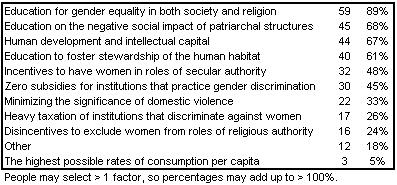 This question was confusing to some participants, but it seems that the answer is education about gender equality -- both secular and religious.
|
| 3 |
DISTRIBUTION OF SELECTED ANSWERS
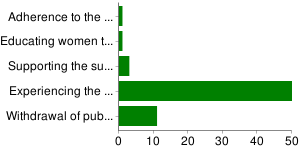 |
SECTION ON EDUCATION FOR GENDER EQUALITY/EQUITY
The header of this question is as follows:
- What is the most effective incentive for eradicating gender inequities?
Select the best answer:
Pareto Ranking
 76% of the participants picked experiencing gender balance in gender and society as the most effective incentive for sustainable development. But what about those who have never experienced gender balance in their culture? 17% picked removing subsidies from patriarchal religious institutions. So 93% think that the most effective incentive is related to either gender balance or hitting the pocketbook of patriarchal institutions.
|
| 4 |
DISTRIBUTION OF SELECTED ANSWERS
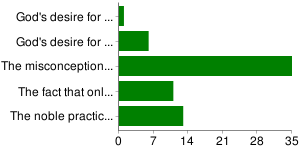 |
SECTION ON EDUCATION FOR GENDER EQUALITY/EQUITY
The header of this question is as follows:
- Which is the greatest obstacle to gender equality?
Select the best answer:
Pareto Ranking
 The Pareto raking seems to confirm that human beings are religious by nature. When religion entails having an exclusively phallic (male-only) image of God, it becomes an obstacle to sustainable development, according to 53% of the respondents. An additional 20% picked the preferential option for boys in advancing their education. This preferential option for boys may be a derivative of having a masculine image of God, but other factors may be involved. The choice about only women being able to be mothers (picked by 17%) was poorly stated. The intent was to check whether the female capacity to bear children has been used to justify their staying at home all the time, and whether or not this has a negative social influence. This item needs careful editing.
|
| 5 |
Comments entered by participants:
Many excellent and insightful comments were entered by the participants. It is not possible to include the full list here. See Spreadsheet V0, Column O.
Distribution of Comments by AQAL Quadrant
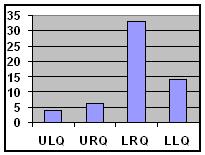
ULQ = Upper Left Quadrant, "What I experience"
URQ = Upper Right Quadrant, "What I do"
LRQ = Lower Right Quadrant, "What we do"
LLQ = Lower Left Quadrant, "What we experience"
| |
SECTION ON EDUCATION FOR GENDER EQUALITY/EQUITY
The header of this question is as follows:
- In your own words, explain how to include the issue of gender equality in education for sustainable development.
Total comments entered: 58
The distribution of comments by AQAL quadrant is based on the number of optional comments entered free format by the responders. Each one of these comments was informally analyzed and assigned to the AQAL quadrants as follows: ULQ if the comment primary focus is on individual consciousness, URQ if the comment primary focus is on individual behavior, LRQ if the comment primary focus is on collective systems, and LLQ if the comment primary focus is on collective culture. Comments such as "not sure" and "xxx" were not counted. The histogram would seem to indicate that most of the responders were thinking in terms of collective systems ("what we do"). Within collective systems, most of the comments were about education and the need to include themes of sustainable development in the education of children.
|
| 6 |
DISTRIBUTION OF SELECTED ANSWERS
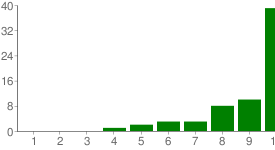
Relevance scale: 1 to 10
1 = Irrelevant, 10 = Critical |
SECTION ON EDUCATION FOR HEALTH PROMOTION
The header of this question is as follows:
- What is the importance of health promotion for sustainable development?
Select the level of importance in a 1-10 scale (1 is irrelevant, 10 is critical).
Pareto Ranking
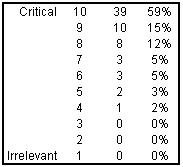 59% of the participants think that improving human health is the top driver of sustainable development, 86% think that it is a key factor.
|
| 7 |
DISTRIBUTION OF SELECTED ANSWERS
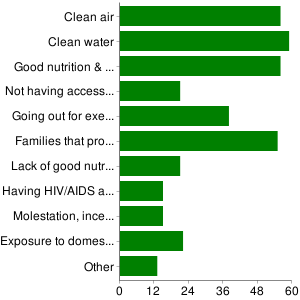 |
SECTION ON EDUCATION FOR HEALTH PROMOTION
The header of this question is as follows:
- Which of the following factors/issues are significant contributors to improving human health?
Select all that apply:
Ranking by Percentage
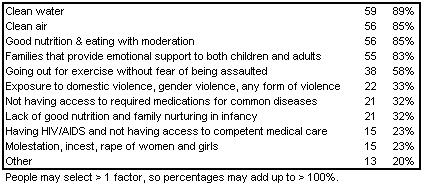 The top four choices (picked by over 80% of the participants) are not surprising. The fifth choice, at 58%, makes some sense. The expectation was that the 6th to 9th choices would be picked by anyone, as it is hard to see how any of those factors can have a positive effect on human health. The language needs refinement. The "other" choice picked by 20% of the responders may be indicative of insufficient coverage.
|
| 8 |
DISTRIBUTION OF SELECTED ANSWERS
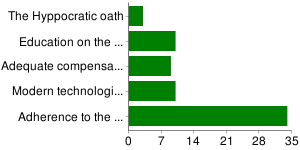 |
SECTION ON EDUCATION FOR HEALTH PROMOTION
The header of this question is as follows:
- What is the most effective incentive for improving health care practices?
Select the best answer:
Pareto Ranking
 At 52%, the top choice makes sense. The choice "education on the gift of love and the gift of life" may need clarification. Surprisingly, only 5% of the respondents felt that the Hyppocratic oath has a positive effect on health care practices. Hopefully, this underestimates the professional ethics of most medical doctors.
|
| 9 |
DISTRIBUTION OF SELECTED ANSWERS
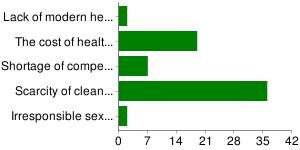 |
SECTION ON EDUCATION FOR HEALTH PROMOTION
The header of this question is as follows:
- Which is the greatest obstacle to improving health care practices?
Select the best answer:
Pareto Ranking
 84% of the respondents pick either the lack of sanitation facilities or the high cost of health care as the main obstacles to improving health care practices. The scarcity of good doctors and nurses in poor countries is worrisome. We have "doctors without borders," but not enough of them; and many doctors and nurses from poor countries are migrating to countries where they get better compensation. We have more health technology than we know what to do with or pay for, so it makes sense that they were picked by few respondents. It is worrisome to see "irresponsible sexual behavior" at the bottom of the pile. Animals sexually behaving like animals do not exonerate humans from sexually behaving as humans.
|
| 10 |
Comments entered by participants:
Many excellent and insightful comments were entered by the participants. It is not possible to include the full list here. See Spreadsheet V0, Column U.
Distribution of Comments by AQAL Quadrant
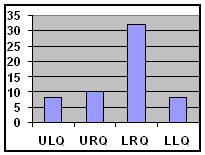
ULQ = Upper Left Quadrant, "What I experience"
URQ = Upper Right Quadrant, "What I do"
LRQ = Lower Right Quadrant, "What we do"
LLQ = Lower Left Quadrant, "What we experience"
| |
SECTION ON EDUCATION FOR HEALTH PROMOTION
The header of this question is as follows:
- In your own words, explain how to include the issue of health promotion in education for sustainable development.
Total comments entered: 58
The distribution of comments by AQAL quadrant is based on informal qualitative analysis as explained in question 5 above. The histogram for question 10 would seem to indicate that most of the responders were thinking in terms of collective systems ("what we do"). Some were thinking in terms of individual behavior ("what I do") and some were thinking in terms of collective culture ("what we experience"), but the dominant perspective is that of "objective" systems. Most of the "what we do" comments were in reference to school curricula and other educational activities.
|
| 11 |
DISTRIBUTION OF SELECTED ANSWERS

Relevance scale: 1 to 10
1 = Irrelevant, 10 = Critical |
SECTION ON EDUCATION FOR ENVIRONMENTAL STEWARDSHIP
The header of this question is as follows:
- What is the importance of environmental stewardship for sustainable development?
Select the level of importance in a 1-10 scale (1 is irrelevant, 10 is critical).
Pareto Ranking
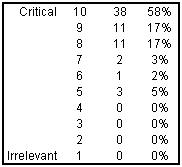 58% of the participants think that environmental management is the top driver of sustainable development, 92% think that it is a key factor.
|
| 12 |
DISTRIBUTION OF SELECTED ANSWERS
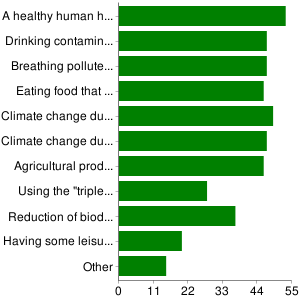 |
SECTION ON EDUCATION FOR ENVIRONMENTAL STEWARDSHIP
The header of this question is as follows:
- Which of the following factors/issues are significant for people to take environmental impacts into account?
Select all that apply:
Ranking by Percentage
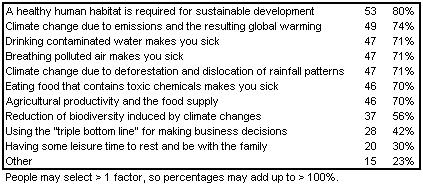 The most frequent (80%) choice is "a healthy human habitat is required for sustainable development." No question about that. The rank ordering of the 2nd to the 8th factors may be debatable, but they are all important factors. So is the 9th, "having some leisure time to rest and be with the family." The frenzy of wealth accumulation is destructive to both people and nature. Cellular phones cannot replace "keeping in touch" and "being with the family." In fact, they reinforce the illusion that multiplexing via widgets can compensate for the rat race and make people happy. The 23% frequency on "other" is again a cause for concern, as it may indicate that the list of options does not provide sufficient coverage of many important ways in which human decisions induce environmental impacts.
|
| 13 |
DISTRIBUTION OF SELECTED ANSWERS
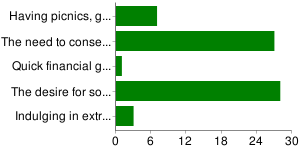 |
SECTION ON EDUCATION FOR ENVIRONMENTAL STEWARDSHIP
The header of this question is as follows:
- What is the most effective incentive for living in harmony with the human habitat?
Select the best answer:
Pareto Ranking
 The Pareto ranking of the five choices would seem to make sense. 83% of respondents selected solidarity or conservation as the best answer. The tight clustering (28/27, 42%/41%) may be indicate that people had to pick either one or the other once the other choices "silly" choices were dropped from consideration. Perhaps this question should have provided a "both/and" (instead of "either/or") choice, i.e., it is the combination of both solidarity and conservation that is critical for environmental sustainability. It is reasonable to infer that 80% or more of the respondents would have chosen this as the best answer.
|
| 14 |
DISTRIBUTION OF SELECTED ANSWERS
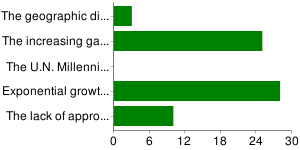 |
SECTION ON EDUCATION FOR ENVIRONMENTAL STEWARDSHIP
The header of this question is as follows:
- Which is the greatest obstacle to environmental sustainability?
Select the best answer:
Pareto Ranking
 There can be no question that "exponential growth in consumption per capita" is the main obstacle to environmental sustainability in the material sense. But is it closely correlated with "the increasing gap between the very rich and the very poor" in the moral sense. It is gratifying to see that almost as many respondents (38%) selected this as the best answer. Again, the combination of both increasingly increasing consumption rates and widening rich-poor gaps is the most deadly obstacle to environmental sustainability. Subsequent revisions of the survey form should be more careful about offering a balance of "either/or" and "both/and" answer selections.
|
| 15 |
Comments entered by participants:
Many excellent and insightful comments were entered by the participants. It is not possible to include the full list here. See Spreadsheet V0, Column AA.
Distribution of Comments by AQAL Quadrant
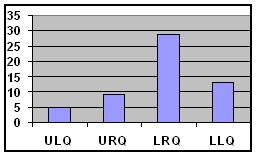
ULQ = Upper Left Quadrant, "What I experience"
URQ = Upper Right Quadrant, "What I do"
LRQ = Lower Right Quadrant, "What we do"
LLQ = Lower Left Quadrant, "What we experience"
| |
SECTION ON EDUCATION FOR RURAL DEVELOPMENT
The header of this question is as follows:
- In your own words, explain how to include environmental values in education for sustainable development.
Total comments entered: 56
The distribution of comments by AQAL quadrant is based on informal qualitative analysis as explained in question 5 above. Again, the histogram for question 15 would seem to indicate that most of the responders were thinking in terms of collective systems ("what we do"). A few were thinking in terms of individual behavior ("what I do"), fewer in terms of collective culture ("what we experience"). Again, most of the "what we do" comments were in reference to educational systems. This is not surprising, as 55% of the participants (question 0) consider themselves to be educators. But 59% of the participants consider themselves to be researchers, yet there are very few suggestions for research in sustainable development. Perhaps many assumed that such research would be done, either before or in conjunction with adding sustainable development subjects to school curricula.
|
| 16 |
DISTRIBUTION OF SELECTED ANSWERS
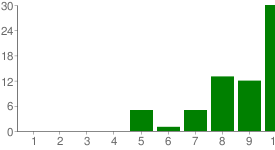
Relevance scale: 1 to 10
1 = Irrelevant, 10 = Critical |
SECTION ON EDUCATION FOR RURAL DEVELOPMENT
The header of this question is as follows:
- What is the importance of rural development for overall sustainable development?
Select the level of importance in a 1-10 scale (1 is irrelevant, 10 is critical).
Pareto Ranking
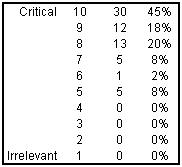 45% of the participants think that rural development is the top driver of sustainable development, 83% think that it is a key factor.
|
| 17 |
DISTRIBUTION OF SELECTED ANSWERS
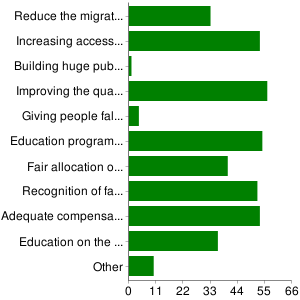 |
SECTION ON EDUCATION FOR RURAL DEVELOPMENT
The header of this question is as follows:
- Which of the following factors/issues are significant to make progress toward rural development?
Select all that apply:
Ranking by Percentage
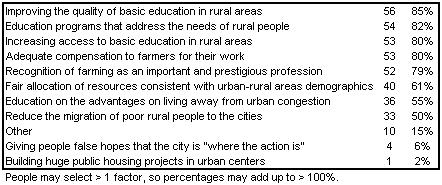 The two obviously wrong answers are at the bottom. The selection "other" (15% here) should be reduced to less than 5% in future revisions of the questionnaire. At the top, "education" is the name of the game, closely followed by compensation and recognition. It is noteworthy that 40% of the responders picked "education on the advantages of living away from urban congestion." This may mean that "education for rural development" is needed in both rural and urban areas.
|
| 18 |
DISTRIBUTION OF SELECTED ANSWERS
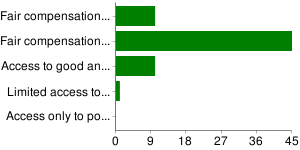 |
SECTION ON EDUCATION FOR RURAL DEVELOPMENT
The header of this question is as follows:
- What is the most effective incentive for rural development?
Select the best answer:
Pareto Ranking
 Compensation is the top incentive (83%). Compensation and affordable health care is a winning combination (98%). Like everybody else, farmers need to make a living and stay healthy. No mystery here.
|
| 19 |
DISTRIBUTION OF SELECTED ANSWERS
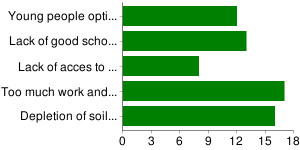 |
SECTION ON EDUCATION FOR RURAL DEVELOPMENT
The header of this question is as follows:
- Which is the greatest obstacle to rural development?
Select the best answer:
Pareto Ranking
 When it is a matter of ranking disincentives, the results are clustered between 12 and 26 percent. None is dominant. But note that they all relate to compensation and health care. The "depletion of soil and forest resources" belongs in the same group, since such depletion decreases the ability of farmers to survive, economically and physically.
|
| 20 |
Comments entered by participants:
Many excellent and insightful comments were entered by the participants. It is not possible to include the full list here. See Spreadsheet V0, Column AG.
Distribution of Comments by AQAL Quadrant
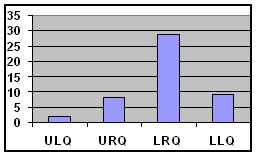
ULQ = Upper Left Quadrant, "What I experience"
URQ = Upper Right Quadrant, "What I do"
LRQ = Lower Right Quadrant, "What we do"
LLQ = Lower Left Quadrant, "What we experience"
| |
SECTION ON EDUCATION FOR RURAL DEVELOPMENT
The header of this question is as follows:
- In your own words, explain how to include the issue of rural development in education for sustainable development.
Total comments entered: 48
The count of comments for each AQAL quadrant is based on the number of optional comments entered free format by the responders for Question 20. Each one of these comments was reviewed as described in Question 5 above. Once again, the histogram would seem to indicate that most of the responders were thinking in terms of collective systems ("what we do"). Within collective systems, most of the comments were about education and the need to include themes of sustainable development in the education of children. There were a few comments about changing the educational systems from "teacher teaches students" to "students learn by doing and asking questions to the teacher," as advocated by Freire. But most participants think that it is a matter of adding sustainable development themes to existing educational systems, albeit with emphasis on starting early in elementary schools.
|
| 21 |
DISTRIBUTION OF SELECTED ANSWERS
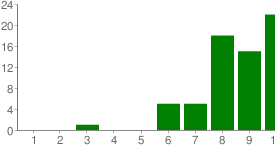
Relevance scale: 1 to 10
1 = Irrelevant, 10 = Critical |
SECTION ON EDUCATION ABOUT CULTURAL DIVERSITY
The header of this question is as follows:
- What is the importance of cultural diversity for sustainable development?
Select the level of importance in a 1-10 scale (1 is irrelevant, 10 is critical).
Pareto Ranking
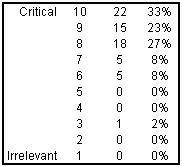 33% of the participants think that embracing cultural diversity is the top driver of sustainable development, 83% think that it is a key factor.
|
| 22 |
DISTRIBUTION OF SELECTED ANSWERS
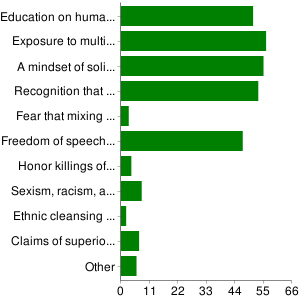 |
SECTION ON EDUCATION ABOUT CULTURAL DIVERSITY
The header of this question is as follows:
- Which of the following factors/issues are significant for nurturing cultural diversity?
Select all that apply:
Ranking by Percentage
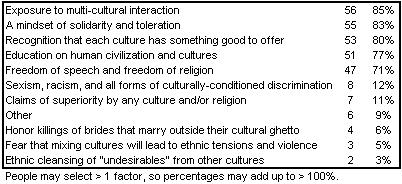 The top selections (85%, 83%, 80%, 77%, 71%) make sense, and it is good to see "sexism, racism, and all forms of culturally-conditioned discrimination" and the other uncivilized answers discarded by most of the participants. However, "exposure to multi-cultural interaction" (learning from experience) may not only be the top one but it may be instrumental for the next four to happen.
|
| 23 |
DISTRIBUTION OF SELECTED ANSWERS
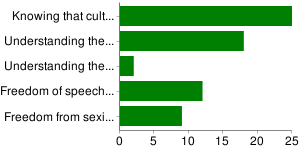 |
SECTION ON EDUCATION ABOUT CULTURAL DIVERSITY
The header of this question is as follows:
- What is the most effective incentive for valuing cultural diversity?
Select the best answer:
Pareto Ranking
 This ranking of options would seem to confirm that "knowing that cultural diversity enriches all cultures" is pivotal, but this is not the kind of knowledge that people get from books. It must be experienced. The same applies to "unity in diversity" (28%) versus "unity in uniformity (3%). Both need to be experienced to know the difference and to know which one is better.
|
| 24 |
DISTRIBUTION OF SELECTED ANSWERS
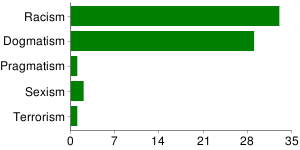 |
SECTION ON EDUCATION ABOUT CULTURAL DIVERSITY
The header of this question is as follows:
- Which is the greatest obstacle to cultural diversity?
Select the best answer:
Pareto Ranking
 This one is very interesting. Nobody wants to be labeled as a racist anymore, which is good. Likewise, nobody wants to be imprisoned by the dogmatism of some secular ideologies and/or religious indoctrination. But what about sexism? Sexism is often coupled to dogmatism (in particular, religious dogmatism) but behaving in a sexist way is not something that most people are ashamed of as of now. It might seem strange to see pragmatism and terrorism ranking lowest as obstacles to sustainable development, but the question was to "select the best answer."
|
| 25 |
Comments entered by participants:
Many excellent and insightful comments were entered by the participants. It is not possible to include the full list here. See Spreadsheet V0, Column AM.
Distribution of Comments by AQAL Quadrant
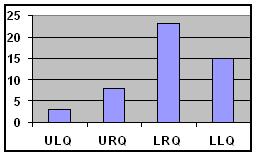
ULQ = Upper Left Quadrant, "What I experience"
URQ = Upper Right Quadrant, "What I do"
LRQ = Lower Right Quadrant, "What we do"
LLQ = Lower Left Quadrant, "What we experience"
| |
SECTION ON EDUCATION ABOUT CULTURAL DIVERSITY
The header of this question is as follows:
- In your own words, explain how to include the benefits of cultural diversity in education for sustainable development.
Total comments entered: 49
The count of comments for each AQAL quadrant is based on the number of optional comments entered free format by the responders for Question 25. Each one of these comments was reviewed as described in Question 5 above. Once again, the histogram would seem to indicate that most of the responders were thinking in terms of collective systems ("what we do"), and most of these pointed to the need to include the benefits of cultural diversity as a theme in school curricula. However, 15 of the 50 answers entered (30%) made reference to the importance of "what we experience." It may be that "cultural diversity" is something that must be experienced in community, and there were some very insightful comments on how to foster such experience in several ways other than education. For instance, social acceptance of inter-racial marriage, willingness to accept and work with LGBT people and people from other cultures (e.g., immigrants), and passive resistance to any form of discrimination and supremacism.
|
| 26 |
DISTRIBUTION OF SELECTED ANSWERS
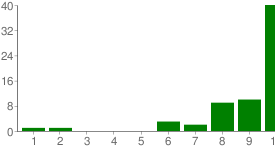
Relevance scale: 1 to 10
1 = Irrelevant, 10 = Critical |
SECTION ON EDUCATION FOR PEACE AND HUMAN SECURITY
The header of this question is as follows:
- What is the importance of peace and human security for sustainable development?
Select the level of importance in a 1-10 scale (1 is irrelevant, 10 is critical).
Pareto Ranking
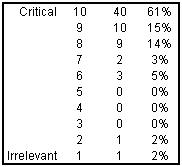 61% of the participants think that the coupling of peace and human security is the top driver of sustainable development, 90% think that it is a key factor.
|
| 27 |
DISTRIBUTION OF SELECTED ANSWERS
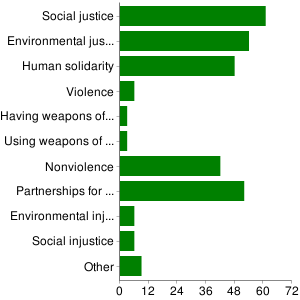 |
SECTION ON EDUCATION FOR PEACE AND HUMAN SECURITY
The header of this question is as follows:
- Which of the following factors/issues are significant to foster peace and improve human security?
Select all that apply:
Ranking by Percentage
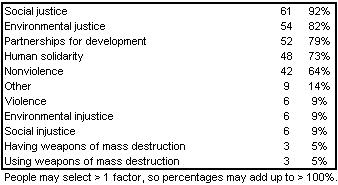 There is nothing surprising about this ranking, especially at the top. The break is at the "other" option, which at 14% may indicate that something was missing among the "good" answers. It is hard to imagine the rationale for selecting "violence," "environmental injustice" and having/using "weapons of mass destruction" as being conducive to peace and human security.
|
| 28 |
DISTRIBUTION OF SELECTED ANSWERS
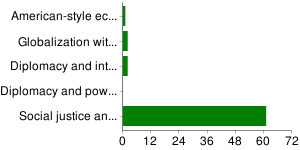 |
SECTION ON EDUCATION FOR PEACE AND HUMAN SECURITY
The header of this question is as follows:
- What is the most effective incentive for peace and human security?
Select the best answer:
Pareto Ranking
 92% of the responders selected "social justice and environmental justice." But here again, perhaps the questionnaire was too simplistic, as any of the other "incentives" is obviously a "disincentive." And what about having "social justice," "environmental justice," and "both social justice and environmental justice" as separate options? Would the "both/and" option still get 92% of the votes as "the best answer"?
|
| 29 |
DISTRIBUTION OF SELECTED ANSWERS
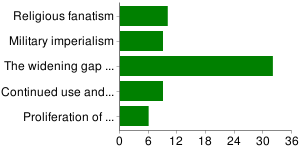 |
SECTION ON EDUCATION FOR PEACE AND HUMAN SECURITY
The header of this question is as follows:
- Which is the greatest obstacle to peace and human security?
Select the best answer:
Pareto Ranking
 The "widening gap between the very rich and the very poor" is now widely recognized as a time bomb waiting to explode. Surely, the continued "widening gap" may be reinforced by "religious fanaticism," "military imperialism," and the "continued use and abuse of the human habitat," but there are probably many other reinforcing factors. In addition to being a time bomb, this "widening gap" is the most shameful failure of modern human civilization.
|
| 30 |
Comments entered by participants:
Many excellent and insightful comments were entered by the participants. It is not possible to include the full list here. See Spreadsheet V0, Column AS.
Distribution of Comments by AQAL Quadrant
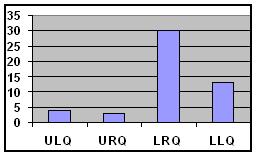
ULQ = Upper Left Quadrant, "What I experience"
URQ = Upper Right Quadrant, "What I do"
LRQ = Lower Right Quadrant, "What we do"
LLQ = Lower Left Quadrant, "What we experience"
| |
SECTION ON EDUCATION FOR PEACE AND HUMAN SECURITY
The header of this question is as follows:
- In your own words, explain how to include the need for peace and human security in education for sustainable development.
Total comments entered: 50
The counts by quadrant are based on informal qualitative review of the comments. The 3rd quadrant ("what we do") again prevails. In something like peace and security, it makes sense for people to think of "we" rather than "I", since it takes at least two to start a war and at least two to declare peace. In fact, any form of violence that compromises human security involves the victim(s) and the victimizer(s). And yet, we all know that one person can have enormous influence in human affairs. Many examples come to mind: Rachel Carson started the environmental movement with a politically incorrect book, and now everyone is trying to become "green"; Martin Luther King Jr revived the civil rights movement in the USA, and the now current tenant at the White House is black; Susan B. Anthony and others come to mind regarding the early years (late 1800s) of the feminist movement, and now we are in the "third wave." Could it be that the survey language is misleading people into thinking in terms of the lower quadrants?
|
| 31 |
DISTRIBUTION OF SELECTED ANSWERS
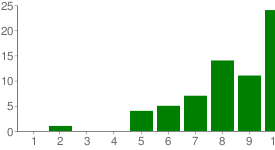
Relevance scale: 1 to 10
1 = Irrelevant, 10 = Critical |
SECTION ON EDUCATION FOR SUSTAINABLE URBANIZATION
The header of this question is as follows:
- What is the importance of urbanization dynamics for sustainable development?
Select the level of importance in a 1-10 scale (1 is irrelevant, 10 is critical).
Pareto Ranking
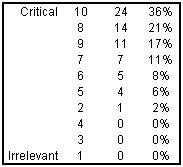 36% of the participants think that sustainable urbanization is the top driver of sustainable development, 74% think that it is a key factor.
|
| 32 |
DISTRIBUTION OF SELECTED ANSWERS
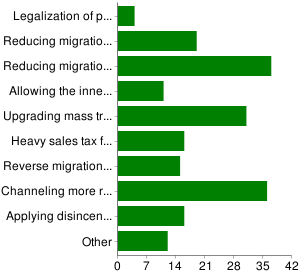 |
SECTION ON EDUCATION FOR SUSTAINABLE URBANIZATION
The header of this question is as follows:
- Which of the following factors/issues are significant for accelerating (or reversing) current urbanization trends?
Select all that apply:
Ranking by Percentage
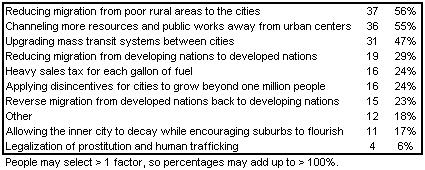 Migration toward urban areas is reinforced by the concentration of resources and public works in the urban areas, to the top two choices are closely related. Having fast, reliable, and affordable mass transit between cities is another good strategy in that it makes it possible for people in rural areas to have access to urban resources and other attractions, including the possibility of commuting to work. After the top three, the gradual decrease in the rankings may be indicative many other factors that the question failed to mention (thus the 18% selection of "other"). Furthermore, the question is ambiguous by referring to both incentives and disincentives to migration.
|
| 33 |
DISTRIBUTION OF SELECTED ANSWERS
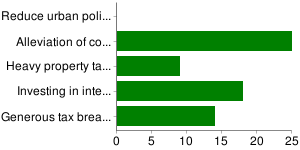 |
SECTION ON EDUCATION FOR SUSTAINABLE URBANIZATION
The header of this question is as follows:
- What is the most effective incentive for sustainable urbanization?
Select the best answer:
Pareto Ranking
 The "alleviation of congestion and pollution" in urban areas certainly would be conducive to sustainable urban development. But this is easier said than done due to human behavior (congestion often replaces the human need for keeping in touch with other humans, albeit in a very superficial way) and the pollution that is inevitably generated by cars, power plants, and the insatiable appetite for heating, air conditioning, and other energy-intensive amenities. The option of limiting (via democratically set property taxes) the growth of cities might be another long-term alternative.
|
| 34 |
DISTRIBUTION OF SELECTED ANSWERS
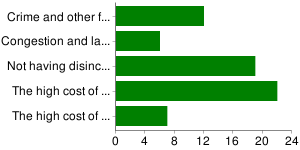 |
SECTION ON EDUCATION FOR SUSTAINABLE URBANIZATION
The header of this question is as follows:
- Which is the greatest obstacle to sustainable urbanization?
Select the best answer:
Pareto Ranking
 The high cost of maintaining the urban infrastructure is at the top, as expected. A surprising results here is the relative high (29%) of responders want to have disincentives to uncontrolled growth of cities. Brasilia was a response to the uncontrolled growth of Rio de Janeiro and Sao Paolo, but the need to open the interior of the country was another decisive factor. Sustainable urbanization is a very tricky issue, with many parts moving. Sustainable urbanization that fuels the uncontrolled growth of cities may not remain sustainable for long.
|
| 35 |
Comments entered by participants:
Many excellent and insightful comments were entered by the participants. It is not possible to include the full list here. See Spreadsheet V0, Column AY.
Distribution of Comments by AQAL Quadrant
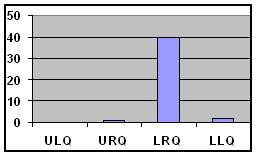
ULQ = Upper Left Quadrant, "What I experience"
URQ = Upper Right Quadrant, "What I do"
LRQ = Lower Right Quadrant, "What we do"
LLQ = Lower Left Quadrant, "What we experience"
| |
SECTION ON EDUCATION FOR SUSTAINABLE URBANIZATION
The header of this question is as follows:
- In your own words, explain how to include the issue of urbanization in education for sustainable development.
Total comments entered: 43
93% of the comments (40/43) are in the LRQ ("what we do"). See Question 5 on how comments were assigned to quadrants. Comments such as "I don't know", "x", and "Pass" were not counted. For this question on sustainable urbanization, the propensity to think in terms of the LRQ was even more pronounced. However, there are many things people can do that would belong in the URQ. For instance, in Havana, Cuba, after 50 years of waiting in line for hours to get food with rationing cards, individuals have started growing fruits and vegetables in their backyards, and many who live in buildings do likewise in any plot of land they can find nearby. Many people also keep chickens, pigs, and other animals in backyard enclosures. People with large backyards also have cows. This reduces the amount of food that must be transported to the city from the rural areas, thus reducing fuel consumption and truck emissions. Luckily, the almost constant sea breeze carries away odors that might be unpleasant, but not so unpleasant as going to bed hungry at night. This kind of "what I do" initiative may not be possible in cities like New York and Paris, but it might be possible in smaller cities in developing countries.
|
| 36 |
DISTRIBUTION OF SELECTED ANSWERS
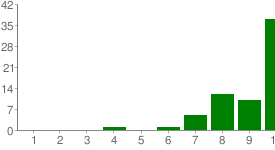
Relevance scale: 1 to 10
1 = Irrelevant, 10 = Critical |
SECTION ON EDUCATION FOR SUSTAINABLE CONSUMPTION
The header of this question is as follows:
- What is the importance of moderating consumption rates for sustainable development?
Select the level of importance in a 1-10 scale (1 is irrelevant, 10 is critical).
Pareto Ranking
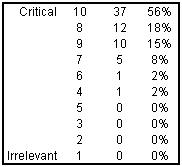 56% of the participants think that environmental management is the top driver of sustainable development, 89% think that it is a key factor.
|
| 37 |
DISTRIBUTION OF SELECTED ANSWERS
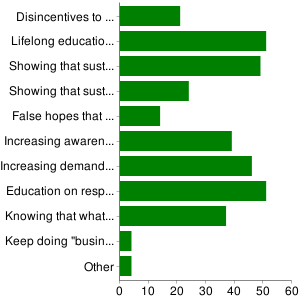 |
SECTION ON EDUCATION FOR SUSTAINABLE CONSUMPTION
The header of this question is as follows:
- Which of the following factors/issues are significant to make progress toward balancing consumption rates?
Select all that apply:
Ranking by Percentage
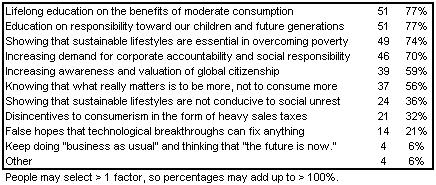 The top two items are a tie at 77%. The can be no doubt that education is key, and this entails cradle to grave education. In education for sustainable development, however, it is not a matter of sitting in a classroom and hear lectures from the experts. The next five items down the ladder all refer to "showing," "demanding," "growing in awareness." Following Freire's guidance, the best way to learn is by doing and experiencing. This may include learning by making mistakes, and then comes the need to ask honest questions and the need to listen to the honest questions and provide answers so as to prevent repetition of the same mistakes. In this sense, the most critical question was missing from the questionnaire: how can traditional educational systems be reformed so as to include "learning by asking, learning by doing, learning by making mistakes and asking again"?
|
| 38 |
DISTRIBUTION OF SELECTED ANSWERS
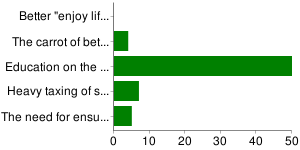 |
SECTION ON EDUCATION FOR SUSTAINABLE CONSUMPTION
The header of this question is as follows:
- What is the most effective incentive for practicing sustainable consumption?
Select the best answer:
Pareto Ranking
 What is the most effective incentive for practicing sustainable consumption? Again, education; and there is a real break between this selection and all the others. And again, what we are facing here is the need for greater reliance on learning by experience. It is always possible to find loopholes in tax laws. People who are in the rate race barely have time to think about today and tomorrow, let alone future generations. Health impacts do not become "real" until one gets sick. For those who can afford it, extravagant consumption is by now and old habit, and old habits die hard.
|
| 39 |
DISTRIBUTION OF SELECTED ANSWERS
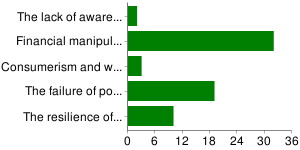 |
SECTION ON EDUCATION FOR SUSTAINABLE CONSUMPTION
The header of this question is as follows:
- Which is the greatest obstacle to sustainable consumption?
Select the best answer:
Pareto Ranking
 48% of the respondents selected "financial manipulations for socially irresponsible quick profits" as the main obstacle to sustainable consumption. Indeed, it is a very tangible obstacle. However, the current financial crisis is a symptom - not the root - of patterns of extravagant consumption by the very rich that persist even though millions are dying of hunger and disease. Not that the very rich should be used as scapegoats for this shameful situation. Blaming the rich is easy, but ineffective in order to close the gap. As Vandana Shiva has pointed out, "resources flow from the poor to the rich, and pollution flows from the rich to the poor." Trying to assign blame to this complex phenomenon is a fruitless exercise. There are no simple answers. The transition from the current global mess to sustainable development is one in which we all shall have to "muddle through" together. How can this survey be unbiased yet cover all the issues that abide deep in the mud?
|
| 40 |
Comments entered by participants:
Many excellent and insightful comments were entered by the participants. It is not possible to include the full list here. See Spreadsheet V0, Column BE.
Distribution of Comments by AQAL Quadrant
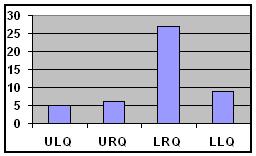
ULQ = Upper Left Quadrant, "What I experience"
URQ = Upper Right Quadrant, "What I do"
LRQ = Lower Right Quadrant, "What we do"
LLQ = Lower Left Quadrant, "What we experience"
| |
SECTION ON EDUCATION FOR SUSTAINABLE CONSUMPTION
The header of this question is as follows:
- In your own words, explain how to include the issue of sustainable consumption in education for sustainable development.
Total comments entered: 47
See Question 5 on how comments were assigned to quadrants. Comments such as "I don't know", "x", and "Pass" were not counted. ESD is mostly perceived as an objective, systemic, collective activity that can be accomplished using the traditional method of education (rather than Freire's "learn by doing"). Accordingly, the influence of personal initiatives (individual actions motivated by personal experience) is rarely mentioned. This propensity to rely on collective cultures/systems rather than individual consciousness/behavior is a constant pattern through most of the comments reviewed in questions 5, 10, 15, 20, 25, 30, 35, and 40. This is remarkable in that most of the responders are personally involved in sustainable development and therefore must have had (at some point) an inner motivation to get started in this profession and stay in sustainable development as their chosen career path. Most of the responders are educators and/or researchers, but they are not mere observers. They are "acting persons" who nevertheless still hope for the cultural/systemic shift that will make sustainable development happen -- perhaps not so much locally but at the national, regional, and global levels.
|